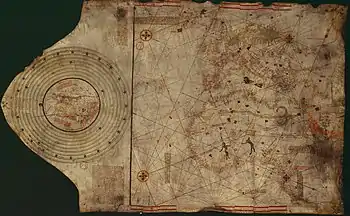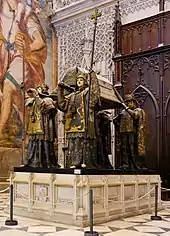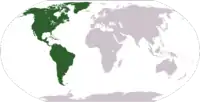Christopher Columbus
Christopher Columbus[lower-alpha 1] (/kəˈlʌmbəs/;[3] between 25 August and 31 October 1451 – 20 May 1506) was an Italian explorer and navigator who completed four voyages across the Atlantic Ocean, opening the way for European exploration and colonization of the Americas. His expeditions, sponsored by the Catholic Monarchs of Spain, were the first European contact with the Caribbean, Central America, and South America.
Admiral of the Ocean Sea Christopher Columbus | |
|---|---|
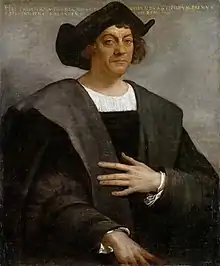 Posthumous portrait of Christopher Columbus by Sebastiano del Piombo, 1519. There are no known authentic portraits of Columbus.[1] | |
| 1st Governor of the Indies | |
| In office 1492–1499 | |
| Appointed by | Isabella I of Castile |
| Succeeded by | Francisco de Bobadilla |
| Personal details | |
| Born | Before 31 October 1451 Genoa, Republic of Genoa |
| Died | 20 May 1506 (aged approximately 54) Valladolid, Castile |
| Resting place | Seville Cathedral, Seville, Spain |
| Spouse(s) | Filipa Moniz Perestrelo |
| Domestic partner | Beatriz Enríquez de Arana |
| Children | Diego Fernando |
| Parents | Domenico Colombo Susanna Fontanarossa |
| Relatives | Brothers: Giovanni Pellegrino Giacomo (also called Diego)[2] Bartholomew Sister: Bianchinetta Columbus |
| Occupation | Maritime explorer |
| Signature | |
| Military service | |
| Rank | Admiral of the Ocean Sea |
Scholars generally agree that Columbus was born in the Republic of Genoa and spoke a dialect of Ligurian as his first language. He went to sea at a young age and travelled widely, as far north as the British Isles and as far south as what is now Ghana. He married Portuguese noblewoman Filipa Moniz Perestrelo and was based in Lisbon for several years, but later took a Castilian mistress; he had one son with each woman. Though largely self-educated, Columbus was widely read in geography, astronomy, and history. He formulated a plan to seek a western sea passage to the East Indies, hoping to profit from the lucrative spice trade. Following Columbus's persistent lobbying to multiple kingdoms, Catholic monarchs Queen Isabella I and King Ferdinand II agreed to sponsor a journey west. Columbus left Castile in August 1492 with three ships, and made landfall in the Americas on 12 October (ending the period of human habitation in the Americas now referred to as the pre-Columbian era). His landing place was an island in the Bahamas, known by its native inhabitants as Guanahani. Columbus subsequently visited the islands now known as Cuba and Hispaniola, establishing a colony in what is now Haiti. This was the first European settlement in the Americas since the Norse colonies begun some 500 years earlier. Columbus returned to Castile in early 1493, bringing a number of captured natives with him. Word of his voyages soon spread throughout Europe.
Columbus made three further voyages to the New World, exploring the Lesser Antilles in 1493, Trinidad and the northern coast of South America in 1498, and the eastern coast of Central America in 1502. Many of the names he gave to geographical features—particularly islands—are still in use. He continued to seek a passage to the East Indies, and the extent to which he was aware that the Americas were a wholly separate landmass is uncertain. He never clearly renounced his belief that he had reached the Far East and gave the name indios ("Indians") to the indigenous peoples he encountered. As a colonial governor, Columbus was accused by his contemporaries of significant brutality and was soon removed from the post. Columbus's strained relationship with the Crown of Castile and its appointed colonial administrators in America led to his arrest and removal from Hispaniola in 1500, and later to protracted litigation over the benefits that he and his heirs claimed were owed to them by the crown. Columbus's expeditions inaugurated a period of exploration, conquest, and colonization that lasted for centuries, helping create the modern Western world. The transfers between the Old World and New World that followed his first voyage are known as the Columbian exchange.
Columbus was widely venerated in the centuries after his death, but public perception has fractured in recent decades as scholars give greater attention to the harm committed under his governance, particularly the near-extermination of Hispaniola's indigenous Taíno population from mistreatment and European diseases, as well as their enslavement. Proponents of the Black Legend theory of history claim that Columbus has been unfairly maligned as part of a wider anti-Catholic sentiment. Many landmarks and institutions in the Western Hemisphere bear his name, including the country of Colombia and the District of Columbia.
Early life
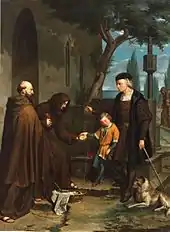
The name Christopher Columbus is the Anglicisation of the Latin Christophorus Columbus. His name in Ligurian is Cristoffa Corombo, in Italian Cristoforo Colombo, and in Spanish Cristóbal Colón.[4] He was born between 25 August and 31 October 1451 in the territory of the Republic of Genoa[5] (now part of modern Italy), though the exact location remains disputed.[6][lower-alpha 2] His father was Domenico Colombo,[4] a wool weaver who worked both in Genoa and Savona and who also owned a cheese stand at which young Christopher worked as a helper. His mother was Susanna Fontanarossa.[4] He had three brothers—Bartolomeo, Giovanni Pellegrino, and Giacomo (also called Diego),[2] as well as a sister named Bianchinetta.[7] His brother Bartolomeo worked in a cartography workshop in Lisbon for at least part of his adulthood.[8]
Columbus never wrote in his native language, which is presumed to have been a Genoese variety of Ligurian: his name in the 16th-century Genoese language would have been Cristoffa[9] Corombo[10] (Ligurian pronunciation: [kriˈʃtɔffa kuˈɹuŋbu]).[11][12] In one of his writings, he says he went to sea at the age of 10. In 1470, the Columbus family moved to Savona, where Domenico took over a tavern. In the same year, Christopher was on a Genoese ship hired in the service of René of Anjou to support his attempt to conquer the Kingdom of Naples. Some modern authors have argued that he was not from Genoa but, instead, from the Aragon region of Spain[13] or from Portugal.[14] These competing hypotheses have generally been discounted by mainstream scholars.[15][16]
In 1473, Columbus began his apprenticeship as business agent for the important Centurione, Di Negro and Spinola families of Genoa. Later, he allegedly made a trip to Chios, an Aegean island then ruled by Genoa.[17] In May 1476, he took part in an armed convoy sent by Genoa to carry valuable cargo to northern Europe. He probably docked in Bristol, England,[18] and Galway, Ireland. He may have also gone to Iceland in 1477.[4][19][20] It is known that in the autumn of 1477, he sailed on a Portuguese ship from Galway to Lisbon, where he found his brother Bartolomeo, and they continued trading for the Centurione family. Columbus based himself in Lisbon from 1477 to 1485. He married Filipa Moniz Perestrelo, daughter of the Porto Santo governor and Portuguese nobleman of Lombard origin Bartolomeu Perestrello.[21]
In 1479 or 1480, his son Diego Columbus was born. Between 1482 and 1485, Columbus traded along the coasts of West Africa, reaching the Portuguese trading post of Elmina at the Guinea coast (in present-day Ghana).[22] Before 1484, Columbus returned to Porto Santo to find that his wife had died.[23] He returned to Portugal to settle her estate and take his son Diego with him.[24] He left Portugal for Castile in 1485, where he found a mistress in 1487, a 20-year-old orphan named Beatriz Enríquez de Arana.[25] It is likely that Beatriz met Columbus when he was in Córdoba, a gathering site of many Genoese merchants and where the court of the Catholic Monarchs was located at intervals. Beatriz, unmarried at the time, gave birth to Columbus's natural son Fernando Columbus in July 1488, named for the monarch of Aragon. Columbus recognized the boy as his offspring. Columbus entrusted his older, legitimate son Diego to take care of Beatriz and pay the pension set aside for her following his death, but Diego was negligent in his duties.[26]

Ambitious, Columbus eventually learned Latin, Portuguese, and Castilian. He read widely about astronomy, geography, and history, including the works of Claudius Ptolemy, Pierre Cardinal d'Ailly's Imago Mundi, the travels of Marco Polo and Sir John Mandeville, Pliny's Natural History, and Pope Pius II's Historia Rerum Ubique Gestarum. According to historian Edmund Morgan,
Columbus was not a scholarly man. Yet he studied these books, made hundreds of marginal notations in them and came out with ideas about the world that were characteristically simple and strong and sometimes wrong ...[27]
Throughout his life, Columbus also showed a keen interest in the Bible and in Biblical prophecies, often quoting biblical texts in his letters and logs. For example, part of the argument that he submitted to the Spanish Catholic Monarchs when he sought their support for his proposed expedition to reach the Indies by sailing west was based on his reading of the Second Book of Esdras (Ezra): see 2 Esdras 6:42, which he took to mean that the Earth is made of six parts of land to one of water. Towards the end of his life, he produced a Book of Prophecies in which his career as an explorer is interpreted in the light of Christian eschatology and of apocalypticism.[8]
Carol Delaney has argued that Columbus was a millennialist and that these beliefs motivated his quest for Asia in a variety of ways.[28] Columbus wrote often about seeking gold in the diaries of his voyages and writes about acquiring the precious metal "in such quantity that the sovereigns… will undertake and prepare to go conquer the Holy Sepulcher".[28] In an account of his fourth voyage, Columbus wrote that "Jerusalem and Mount Sion must be rebuilt by Christian hands".[29] It has also been written that "conversion of all people to the Christian faith" is a central theme in Columbus's writings which is a central tenet of some Millenarian beliefs.[28] In a more specific identification of his motivations, Hamandi writes that the "deliverance of Jerusalem from Muslim hands" could be accomplished by "using the resources of newly discovered lands".[30]
Quest for Asia
Background

Under the Mongol Empire's hegemony over Asia (the Pax Mongolica, or Mongol peace), Europeans had long enjoyed a safe land passage, the Silk Road, to the Indies (then construed roughly as all of south and east Asia) and China, which were sources of valuable goods such as spices and silk. With the fall of Constantinople to the Ottoman Turks in 1453, the land route to Asia was closed to Christian traders.[31] Portuguese navigators tried to find a sea way to Asia.
In 1470, the Florentine astronomer Paolo dal Pozzo Toscanelli suggested to King Afonso V of Portugal that sailing west across the Atlantic would be a quicker way to reach the Spice Islands, Cathay, and Cipangu than the route around Africa, but Afonso rejected his proposal.[32] In the 1480s, the Columbus brothers proposed a plan to reach the Indies by sailing west across the "Ocean Sea" (the Atlantic). By 1481, Toscanelli had sent Columbus a map implying that a westward route to Asia was possible.[33][34] Columbus's plans were complicated by the opening of the southeast passage to Asia around Africa by Bartolomeu Dias in 1488, when he reached the Cape of Good Hope (modern-day South Africa).[35]
Geographical considerations
Nearly all educated Westerners had understood, at least since the time of Aristotle, that the Earth is spherical.[36][37][35] The sphericity of the Earth is also accounted for in the work of Ptolemy, on which medieval astronomy was largely based. In Columbus's time, the techniques of celestial navigation, which use the position of the sun and the stars in the sky, together with the understanding that the Earth is a sphere, had long been in use by astronomers and were beginning to be implemented by mariners.[38]
As far back as the 3rd century BC, Eratosthenes had correctly computed the circumference of the Earth by using simple geometry and studying the shadows cast by objects at two remote locations.[39][40] In the 1st century BC, Posidonius confirmed Eratosthenes's results by comparing stellar observations at two separate locations. These measurements were widely known among scholars, but Ptolemy's use of the smaller, old-fashioned units of distance led Columbus to underestimate the size of the Earth by about a third.[41]
From Pierre d'Ailly's Imago Mundi (1410) Columbus learned of Alfraganus's estimate that a degree of latitude (or a degree of longitude along the equator) spanned 562⁄3 Arabic miles (equivalent to 66.2 nautical miles or 122.6 kilometres), but he did not realize that this was expressed in the Arabic mile (about 1,830 meters) rather than the shorter Roman mile (about 1,480 meters) with which he was familiar.[43] Columbus therefore estimated the size of the Earth to be about 75% of Eratosthenes's calculation, and the distance from the Canary Islands to Japan as 2,400 nautical miles (about 23% of the real figure).[44]
Furthermore, most scholars accepted Ptolemy's estimate that Eurasia spanned 180° longitude, rather than the actual 130° (to the Chinese mainland) or 150° (to Japan at the latitude of Spain). Columbus, for his part, believed an even higher estimate, leaving a smaller percentage for water. In d'Ailly's Imago Mundi, Columbus read Marinus of Tyre's estimate that the longitudinal span of Eurasia was 225°.[45] Other people have suggested he followed Esdras's statement that "six parts [of the globe] are habitable and the seventh is covered with water."[46] He was also aware of Marco Polo's claim that Japan (which he called "Cipangu") was some 2,414 kilometres (1,500 mi) to the east of China ("Cathay"),[45] and closer to the equator than it is. He was influenced by Toscanelli's idea that there were inhabited islands even farther to the east than Japan, including the mythical Antillia, which he thought might lie not much farther to the west than the Azores.[46]
Columbus therefore would have estimated the distance from the Canary Islands west to Japan to be about 9,800 kilometres (5,300 nmi) or 3,700 kilometres (2,000 nmi), depending on which estimate he used for Eurasia's longitudinal span. The true figure is now known to be vastly larger: about 20,000 kilometres (11,000 nmi).[47][lower-alpha 3] No ship in the 15th century could have carried enough food and fresh water for such a long voyage, and the dangers involved in navigating through the uncharted ocean would have been formidable. Most European navigators reasonably concluded that a westward voyage from Europe to Asia was unfeasible. The Catholic Monarchs, however, having completed an expensive war in the Iberian Peninsula, were eager to obtain a competitive edge over other European countries in the quest for trade with the Indies. Columbus's project, though far-fetched, held the promise of such an advantage.[48]
Nautical considerations
Though Columbus was wrong about the number of degrees of longitude that separated Europe from the Far East and about the distance that each degree represented, he did possess valuable knowledge about the trade winds, which would prove to be the key to his successful navigation of the Atlantic Ocean. To return to Spain against this prevailing wind would have required several months of an arduous sailing technique, called beating, during which food and drinkable water would probably have been exhausted. Instead, Columbus returned home by following the curving trade winds northeastward to the middle latitudes of the North Atlantic, where he was able to catch the "westerlies" that blow eastward to the coast of Western Europe. There, in turn, the winds curve southward towards the Iberian Peninsula.
It is unclear whether Columbus learned about the winds from his own sailing experience or if he had heard about them from others. The corresponding technique for efficient travel in the Atlantic appears to have been exploited first by the Portuguese, who referred to it as the Volta do mar ("turn of the sea"). Columbus's knowledge of the Atlantic wind patterns was, however, imperfect at the time of his first voyage. By sailing directly due west from the Canary Islands during hurricane season, skirting the so-called horse latitudes of the mid-Atlantic, Columbus risked either being becalmed or running into a tropical cyclone, both of which, by chance, he avoided.[46]
Quest for financial support for a voyage
.png.webp)
By about 1484, Columbus proposed his planned voyage to King John II of Portugal.[49] The king submitted Columbus's proposal to his experts, who rejected it on the correct belief that Columbus's estimate for a voyage of 2,400 nautical miles was only a quarter of what it should have been.[50] Columbus traveled from Portugal to both Genoa and Venice, but he received encouragement from neither. In 1488, Columbus again appealed to the court of Portugal, resulting in John II again inviting him for an audience. That meeting also proved unsuccessful, in part because not long afterwards Bartolomeu Dias returned to Portugal with news of his successful rounding of the southern tip of Africa (near the Cape of Good Hope).[51]
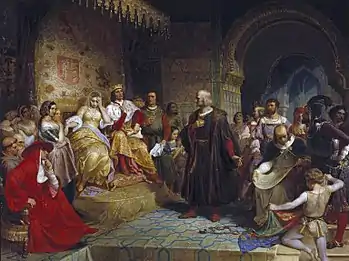
Columbus sought an audience from the monarchs Ferdinand II of Aragon and Isabella I of Castile, who had united several kingdoms in the Iberian Peninsula by marrying and were ruling together. On 1 May 1486, permission having been granted, Columbus presented his plans to Queen Isabella, who, in turn, referred it to a committee. The savants of Spain, like their counterparts in Portugal, replied that Columbus had grossly underestimated the distance to Asia. They pronounced the idea impractical and advised their Royal Highnesses to pass on the proposed venture. To keep Columbus from taking his ideas elsewhere, and perhaps to keep their options open, the Catholic monarchs gave him an allowance, totaling about 14,000 maravedis for the year, or about the annual salary of a sailor.[53] In May 1489, the queen sent him another 10,000 maravedis, and the same year the monarchs furnished him with a letter ordering all cities and towns under their domain to provide him food and lodging at no cost.[54]
Columbus also dispatched his brother Bartholomew to the court of Henry VII of England to inquire whether the English crown might sponsor his expedition, but he was captured by pirates in the process, and only arrived in early 1491.[55] By that time, Columbus had retreated to La Rábida Friary, where the Spanish crown sent him 20,000 maravedis to buy new clothes and instructions to return to the Spanish court for renewed discussions.[56]
Agreement with the Spanish crown
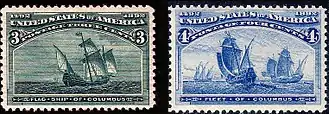
Columbus waited at King Ferdinand's camp until Ferdinand and Isabella conquered Granada, the last Muslim stronghold on the Iberian Peninsula, in January 1492. A council led by Isabella's confessor, Hernando de Talavera, found Columbus's proposal to reach the Indies implausible. Columbus had left for France when Ferdinand intervened,[lower-alpha 4] first sending Talavera and Bishop Diego Deza to appeal to the queen.[57] Isabella was finally convinced by the king's clerk Luis de Santángel, who argued that Columbus would bring his ideas elsewhere, and offered to help arrange the funding. Isabella then sent a royal guard to fetch Columbus, who had travelled several kilometers toward Córdoba.[57]
In the April 1492 "Capitulations of Santa Fe", King Ferdinand and Queen Isabella promised Columbus that if he succeeded he would be given the rank of Admiral of the Ocean Sea and appointed Viceroy and Governor of all the new lands he could claim for Spain. He had the right to nominate three persons, from whom the sovereigns would choose one, for any office in the new lands. He would be entitled to 10 percent of all the revenues from the new lands in perpetuity. Additionally, he would also have the option of buying one-eighth interest in any commercial venture with the new lands and receive one-eighth of the profits.[46]
Columbus was later arrested in 1500 and dismissed from his posts. He and his sons, Diego and Fernando, then conducted a lengthy series of court cases against the Castilian crown, known as the pleitos colombinos, alleging that the Crown had illegally reneged on its contractual obligations to Columbus and his heirs. The Columbus family had some success in their first litigation, as a judgment of 1511 confirmed Diego's position as viceroy, but reduced his powers. Diego resumed litigation in 1512, which lasted until 1536, and further disputes continued until 1790.[58]
Voyages
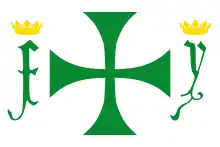
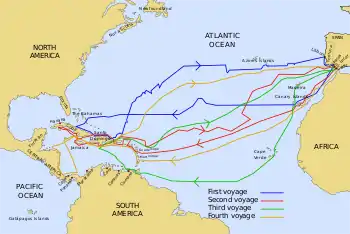
Between 1492 and 1504, Columbus completed four round-trip voyages between Spain and the Americas, each voyage being sponsored by the Crown of Castile. On his first voyage, he independently discovered the Americas. These voyages marked the beginning of the European exploration and colonization of the Americas, and are thus important to both the Age of Discovery and Western history writ large.[8]
Columbus always insisted, in the face of mounting evidence to the contrary, that the lands that he visited during those voyages were part of the Asian continent, as previously described by Marco Polo and other European travelers.[8] Columbus's refusal to accept that the lands he had visited and claimed for Spain were not part of Asia might explain, in part, why the American continent was named after the Florentine explorer Amerigo Vespucci and not after Columbus.[59][lower-alpha 5]
First voyage (1492–1493)

On the evening of 3 August 1492, Columbus departed from Palos de la Frontera with three ships. The largest was a carrack, the Santa María, owned and captained by Juan de la Cosa, and under Columbus's direct command.[63] The other two were smaller caravels, nicknamed the Pinta ('painted one') and the Niña ('girl'),[64] piloted by the Pinzón brothers (Martín Alonso and Vicente Yáñez, respectively).[63] Columbus first sailed to the Canary Islands, which had been largely conquered by Castile. He restocked provisions and made repairs then departed from San Sebastián de La Gomera on 6 September,[65] for what turned out to be a five-week voyage across the ocean.
On 13 September 1492, Columbus observed that the needle of his compass no longer pointed to the North Star. It was once believed that Columbus had discovered magnetic declination, but it was later shown that the phenomenon was already known, both in Europe and in China.[66][lower-alpha 7]
On 7 October, the crew spotted "[i]mmense flocks of birds".[68] On 11 October, Columbus changed the fleet's course to due west, and sailed through the night, believing land was soon to be found. At around 10:00 in the evening he thought he saw a light "like a little wax candle rising and falling".[69][lower-alpha 8] Four hours later, a lookout on the Pinta, Rodrigo de Triana, spotted land, and immediately alerted the rest of the crew with a shout. Thereupon, the captain of the Pinta, Martín Alonso Pinzón, verified the sight of land and alerted Columbus by firing a lombard.[70][71] Columbus later maintained that he had already seen a light on the land a few hours earlier, thereby claiming for himself the lifetime pension promised by Ferdinand and Isabella to the first person to sight land.[35][72] Columbus called this island (in what is now the Bahamas) San Salvador (meaning "Holy Savior"); the natives called it Guanahani.[73][lower-alpha 9] Columbus wrote of the indigenous people he first encountered in his journal entry of 12 October 1492:
Many of the men I have seen have scars on their bodies, and when I made signs to them to find out how this happened, they indicated that people from other nearby islands come to San Salvador to capture them; they defend themselves the best they can. I believe that people from the mainland come here to take them as slaves. They ought to make good and skilled servants, for they repeat very quickly whatever we say to them. I think they can very easily be made Christians, for they seem to have no religion. If it pleases our Lord, I will take six of them to Your Highnesses when I depart, in order that they may learn our language.[75]
.jpg.webp)
Columbus called the inhabitants of the lands that he visited indios (Spanish for "Indians").[76][77][78] He initially encountered the Lucayan, Taíno, and Arawak peoples. Noting their gold ear ornaments, Columbus took some of the Arawaks prisoner and insisted that they guide him to the source of the gold.[79] Columbus noted that their primitive weapons and military tactics made the natives susceptible to easy conquest, writing, "these people are very simple in war-like matters ... I could conquer the whole of them with 50 men, and govern them as I pleased."[80]
Columbus also explored the northeast coast of Cuba, where he landed on 28 October. On 22 November, Martín Alonso Pinzón took the Pinta on an unauthorized expedition in search of an island called "Babeque" or "Baneque", which the natives had told him was rich in gold. Columbus, for his part, continued to the northern coast of Hispaniola, where he landed on 5 December.[81] There, the Santa María ran aground on Christmas Day 1492 and had to be abandoned. The wreck was used as a target for cannon fire to impress the native peoples.[35] Columbus was received by the native cacique Guacanagari, who gave him permission to leave some of his men behind. Columbus left 39 men, including the interpreter Luis de Torres,[82][lower-alpha 10] and founded the settlement of La Navidad, in present-day Haiti.[83] Columbus took more natives prisoner and continued his exploration.[79] He kept sailing along the northern coast of Hispaniola with a single ship, until he encountered Pinzón and the Pinta on 6 January.

On 13 January 1493, Columbus made his last stop of this voyage in the New World, in the Bay of Rincón at the eastern end of the Samaná Peninsula in northeast Hispaniola.[84] There he encountered the warlike Ciguayos, the only natives who offered violent resistance during his first voyage to the Americas.[85] The Ciguayos refused to trade the amount of bows and arrows that Columbus desired; in the ensuing clash one Ciguayo was stabbed in the buttocks and another wounded with an arrow in his chest.[86] Because of these events, Columbus called the inlet the Bay of Arrows.[87]
Columbus headed for Spain on the Niña, but a storm separated him from the Pinta, and forced the Niña to stop at the island of Santa Maria in the Azores. Half of his crew went ashore to say prayers in a chapel to give thanks for having survived the storm. But while praying, they were imprisoned by the governor of the island, ostensibly on suspicion of being pirates. After a two-day standoff, the prisoners were released, and Columbus again set sail for Spain.[88]
Another storm forced him into the port at Lisbon.[35] He anchored next to the King's harbor patrol ship on 4 March 1493 in Portugal. There, he was interviewed by Bartolomeu Dias, who had rounded the Cape of Good Hope a few years earlier, in 1488–1489. Dias's success had complicated Columbus's attempts to secure funding from the Portuguese court because the sure route to the Indies that Dias pioneered made a risky, conjectural western route unnecessary.[35] Not finding King John II of Portugal in Lisbon, Columbus wrote a letter to him and waited for John's reply. John asked Columbus to go to Vale do Paraíso north of Lisbon to meet him. Relations between Portugal and Castile were poor at the time. Columbus went to meet with John at Vale do Paraíso. Hearing of Columbus's voyage, John told him that he believed the voyage to be in violation of the 1479 Treaty of Alcáçovas.
After spending more than a week in Portugal, and paying his respects to Eleanor of Viseu, Columbus again set sail for Spain. Ferdinand Magellan was a young boy and a ward of Eleanor's court; it is likely he saw Columbus during this visit.[35] Returning on 15 March 1493, Columbus was given a warm welcome by the monarchs. Word of his voyage rapidly spread throughout Europe. Most people initially believed that he had reached Asia.[89] A series of papal orders laid the groundwork for how Spain and Portugal would divide the spoils of newly explored lands.[90]
Second voyage (1493–1496)
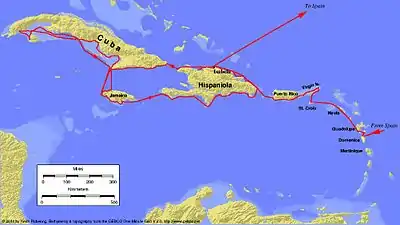
Columbus left the port of Cádiz on 24 September 1493, with a fleet of 17 ships carrying 1,200 men and the supplies to establish permanent colonies in the New World. The passengers included priests, farmers, and soldiers, who would be the new colonists. This reflected the new policy of creating not just "colonies of exploitation", but also "colonies of settlement" from which to launch missions dedicated to converting the natives to Christianity.[91] Modern studies suggest that "crew members may have included free black Africans who arrived in the New World about a decade before the slave trade began".[92]
As in the first voyage, the fleet stopped at the Canary Islands, from which it departed on 13 October, following a more southerly course than on the previous expedition. On 3 November, Columbus sighted a rugged island that he named Dominica (Latin for Sunday); later that day, he landed at Marie-Galante, which he named Santa María la Galante. After sailing past Les Saintes (Los Santos, "The Saints"), he arrived at the island of Guadeloupe, which he named Santa María de Guadalupe de Extremadura, after the image of the Virgin Mary venerated at the Spanish monastery of Villuercas, in Guadalupe, Cáceres, Spain. He explored that island from 4 to 10 November.
Michele da Cuneo, Columbus's childhood friend from Savona, sailed with Columbus during the second voyage and wrote: "In my opinion, since Genoa was Genoa, there was never born a man so well equipped and expert in the art of navigation as the said lord Admiral."[93] Columbus named the small island of "Saona ... to honor Michele da Cuneo, his friend from Savona."[94] Pedro de las Casas, father of the priest Bartolomé de las Casas, also accompanied Columbus on this voyage.[95]
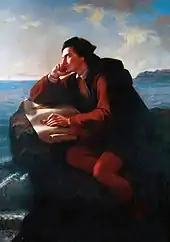
The exact course of Columbus's voyage through the Lesser Antilles is debated, but it seems likely that he turned north, sighting and naming several islands, including:
- Montserrat (for Santa María de Montserrat, after the Blessed Virgin of the Monastery of Montserrat, which is located on the Mountain of Montserrat, in Catalonia, Spain),
- Antigua (after a church in Seville, Spain, called Santa María la Antigua, meaning "Old St. Mary's"),
- Redonda (Santa María la Redonda, Spanish for "St. Mary the Round", owing to the island's shape),
- Nevis (derived from the Spanish Nuestra Señora de las Nieves, "Our Lady of the Snows", because Columbus thought the clouds over Nevis Peak made the island resemble a snow-capped mountain),
- Saint Kitts (for St. Christopher, patron of sailors and travelers),
- Sint Eustatius (for the early Roman martyr, St. Eustachius),
- Saba (after the Biblical Queen of Sheba),
- Saint Martin (San Martín), and
- Saint Croix (from the Spanish Santa Cruz, meaning "Holy Cross").[96]
Columbus also sighted the chain of the Virgin Islands, which he named Islas de Santa Úrsula y las Once Mil Vírgenes, "Islands of Saint Ursula and the 11,000 Virgins" (shortened, both on maps of the time and in common parlance, to Islas Vírgenes). He also named the islands of Virgin Gorda ("Fat Virgin"), Tortola, and Peter Island (San Pedro).
One of the first skirmishes between Native Americans and Europeans since the time of the Vikings occurred on 14 November, when at Saint Croix, Columbus's men pursued the canoe of some Island Caribs and their prisoners, which met them with arrows. At least one European was fatally wounded, and all of the inhabitants of the canoe were killed or captured. Michele da Cuneo, who took part in the battle, reported that Columbus let him keep one of the captured women, whom he beat and raped.[97][98][lower-alpha 11] Columbus continued to the Virgin Islands, and landed in Puerto Rico, which he named San Juan Bautista[100] in honor of Saint John the Baptist (a name that was later given to the capital city of San Juan). Here, on 19 November, the Europeans rescued some women from a group of at least 20 that the local Caribs had been keeping as sex slaves. The women explained that any male captives were eaten, and that their own male offspring were castrated and made to serve the Caribs until they were old enough to be considered good to eat. The Europeans rescued three of these boys.[101]
On 22 November, Columbus returned to Hispaniola, where he intended to visit the fort of La Navidad. Columbus found the fort in ruins, destroyed by the Taínos.[102] Among the ruins were the corpses of 11 of the 39 Spaniards who had stayed behind as the first colonists in the New World. Columbus then sailed more than 100 kilometres (62 miles) eastwards along the northern coast of Hispaniola, establishing a new settlement, which he called La Isabela, in the present-day Dominican Republic.[103] However, La Isabela proved to be poorly located and the settlement was short-lived.
Slavery, settlers, and tribute
In 1494, Columbus sent Alonso de Ojeda (whom a contemporary described as "always the first to draw blood wherever there was a war or quarrel") to Cibao (where gold was being mined for),[104] which resulted in Ojeda's capturing several natives on an accusation of theft. Ojeda cut the ears off of one native, and sent the others to La Isabela in chains, where Columbus ordered them to be decapitated.[105] During his brief reign, Columbus executed Spanish colonists for minor crimes, and used dismemberment as another form of punishment.[106] By the end of 1494, disease and famine had claimed two-thirds of the Spanish settlers.[107][108] A native Nahuatl account depicted the social breakdown that accompanied the epidemic: "A great many died from this plague, and many others died of hunger. They could not get up to search for food, and everyone else was too sick to care for them, so they starved to death in their beds."[109]
By 1494, Columbus had shared his viceroyship with one of his military officers named Margarit, ordering him to prioritize Christianizing the natives, but that part of their noses and ears should be cut off for stealing. Margarit's men exploited the natives by beating, raping and enslaving them, with none on Hispaniola being baptized for another two years. Columbus's brother Diego warned Margarit to follow the admiral's orders, which provoked him to take three caravels back to Spain. Fray Buil, who was supposed to perform baptisms, accompanied Margarit. After arriving in Spain in late 1494, Buil complained to the Spanish court of the Columbus brothers and that there was no gold. Groups of Margarit's soldiers who remained in the west continued brutalizing the natives. Instead of forbidding this, Columbus participated in enslaving the indigenous people.[110] In February 1495, he took over 1,500 Arawaks, some of whom had rebelled against the oppression of the colonists,[79][111] and many of whom were subsequently released or taken by the Caribs.[112] That month, Columbus shipped approximately 500 of these Americans to Spain to be sold as slaves; about 40% died en route,[79][111] and half of the rest were sick upon arrival. In June of that year, the Spanish crown sent ships and supplies to the colony on Hispaniola, which Florentine merchant Gianotto Berardi had helped procure.[lower-alpha 12] In October, Berardi received almost 40,000 maravedís worth of slaves, who were alleged to be either cannibals or prisoners.[lower-alpha 13]
The natives of Hispaniola were systematically subjugated via the encomienda system Columbus implemented.[115] Adapted from Spain, it resembled the feudal system in Medieval Europe, as it was based on a lord offering "protection" to a class of people who owed labour.[116] In addition, Spanish colonists under Columbus's rule began to buy and sell natives as slaves, including children.[117] Columbus's forced labour system was described by his son Ferdinand: "In the Cibao, where the gold mines were, every person of fourteen years of age or upward was to pay a large hawk's bell of gold dust;[lower-alpha 14] all others were each to pay twenty-five pounds of cotton. Whenever an Indian delivered his tribute, he was to receive a brass or copper token which he must wear about his neck as proof that he had made his payment; any Indian found without such a token was to be punished."[104] The monarchs, who suggested the tokens, called for a light punishment,[118] but any Indian found without a copper token had their hands cut off, which was a likely death sentence.[119] Since there was no abundance of gold on the island, the natives had no chance of meeting Columbus' quota and thousands are reported to have committed suicide.[120][lower-alpha 15]
Columbus fell ill in 1495, and, as David Stannard writes, "what little restraint he had maintained over his men disappeared as he went through a lengthy period of recuperation. The troops went wild, stealing, killing, raping, and torturing natives, trying to force them to divulge the whereabouts of the imagined treasure-houses of gold."[122] According to Las Casas, 50,000 natives perished during this period (although his account has been criticized by modern historians as lacking objectivity and his population estimates are often dismissed).[123] After recovering, Columbus organized his troops' efforts, forming a squadron of several hundred heavily armed men and more than twenty attack dogs.[124] Columbus's men and dogs hunted down and killed natives who attempted to flee, as well as thousands who were sick and unarmed.[124][111] Las Casas recounts that the hands of their captives would be cut off and left "dangling by a shred of skin" as a warning to their tribe; further, the soldiers placed wagers on their ability to use their sword to decapitate them or cut them in half with a single blow.[124] The Arawaks attempted to fight back against Columbus's men but lacked their armor, guns, swords, and horses. When taken prisoner, they were hanged or burned to death. According to Bartolomé de Las Casas, natives were hung in groups of thirteen "in memory of Our Redeemer and His twelve Apostles."[111] When natives on Hispaniola began fighting back against their oppressors, Columbus's men captured 1,500 Arawak men, women, and children in a single raid. The strongest 500 were sent to Spain to be sold as slaves, with 40% of these dying en route.[79][111]
Third voyage (1498–1500)
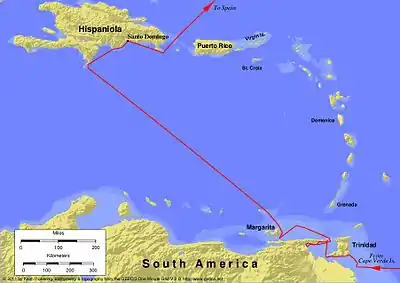
A major objective of the third voyage was to verify the existence of a continent that King John II of Portugal suggested was located to the southwest of Cape Verde.[lower-alpha 16] On 30 May 1498, Columbus left with six ships from Sanlúcar, Spain, for his third trip to the New World. Three of the ships headed directly for Hispaniola with much-needed supplies, while Columbus took the other three in an exploration of what might lie to the south of the Caribbean islands he had already visited, including a hoped-for passage to continental Asia.[127] Columbus led his fleet to the Portuguese island of Porto Santo, his wife's native land. He then sailed to Madeira and spent some time there before sailing to the Canary Islands and Cape Verde.
After being becalmed for several days in the doldrums of the mid-Atlantic, Columbus's fleet regained its wind and, low on water, turned north in the direction of Dominica. The men sighted the land of Trinidad on 31 July, approaching from the southeast.[128] The fleet sailed along the southern coast and entered Dragon's Mouth, anchoring near Soldado Rock (west of Icacos Point, Trinidad's southwesternmost point) where they made contact with a group of Amerindians in canoes.[129] On 1 August, Columbus and his men arrived at a landmass near the mouth of South America's Orinoco river. Columbus recognized that it must be the continent's mainland, but still believed it to be Asia. While he did not go ashore at this time, one of his men planted the Spanish flag there.[130] On 2 August, Columbus and his men landed at Icacos Point.[131] From 4 to 12 August, they explored the Gulf of Paria, which separates Trinidad from what is now Venezuela, near the delta of the Orinoco. On 5 August, they landed on the mainland of South America at the Paria Peninsula.[132] Columbus then sailed to the islands of Chacachacare and Margarita (reaching the latter on 14 August),[133] and sighted Tobago and Grenada.[134]
In poor health, Columbus returned to Hispaniola on 19 August, only to find that many of the Spanish settlers of the new colony were in rebellion against his rule, claiming that Columbus had misled them about the supposedly bountiful riches of the New World. A number of returning settlers and sailors lobbied against Columbus at the Spanish court, accusing him and his brothers of gross mismanagement. Columbus had some of his crew hanged for disobedience. He had an economic interest in the enslavement of the Hispaniola natives and for that reason was not eager to baptize them, which attracted criticism from some churchmen.[135] An entry in his journal from September 1498 reads: "From here one might send, in the name of the Holy Trinity, as many slaves as could be sold ..."[136]
Accusations of tyranny
In October 1499, Columbus sent two ships to Spain, asking the Court of Spain to appoint a royal commissioner to help him govern.[137] By this time, accusations of tyranny and incompetence on the part of Columbus had also reached the Court. In 1500, the Crown had him removed as governor, arrested, and transported in chains to Spain.[138] The sovereigns replaced him with Francisco de Bobadilla, a member of the Order of Calatrava. Bobadilla had also been tasked by the Court with investigating the accusations of brutality made against Columbus. Arriving in Santo Domingo while Columbus was away during the explorations of his third voyage, Bobadilla was immediately met with complaints about all three Columbus brothers: Christopher, Bartolomeo, and Diego.[139] Bobadilla reported to Spain that Columbus regularly used torture and mutilation to govern Hispaniola.[lower-alpha 17]
According to the report, Columbus once punished a man found guilty of stealing corn by having his ears and nose cut off and then selling him into slavery. Testimony recorded in the report stated that Columbus congratulated his brother Bartolomeo on "defending the family" when the latter ordered a woman paraded naked through the streets and then had her tongue cut out for suggesting that Columbus was of lowly birth.[140] The document also describes how Columbus put down native unrest and revolt: he first ordered a brutal crackdown in which many natives were killed, and then paraded their dismembered bodies through the streets in an attempt to discourage further rebellion.[141]
In early October 1500, Columbus and Diego presented themselves to Bobadilla, and were put in chains aboard La Gorda, Columbus's own ship.[142] They were returned to Spain, and lingered in jail for six weeks before King Ferdinand ordered their release. Not long after, the king and queen summoned the Columbus brothers to the Alhambra palace in Granada. There, the royal couple heard the brothers' pleas; restored their freedom and wealth; and, after much persuasion, agreed to fund Columbus's fourth voyage. But the door was firmly shut on Columbus's role as governor. Henceforth Nicolás de Ovando y Cáceres was to be the new governor of the West Indies.[138]
Fourth voyage (1502–1504)
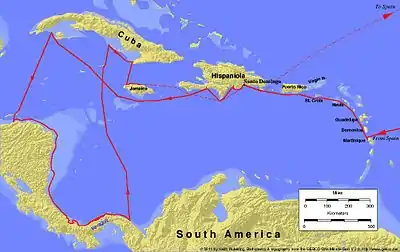
.svg.png.webp)
Columbus made a fourth voyage nominally in search of the Strait of Malacca to the Indian Ocean.[143] Accompanied by his brother Bartolomeo and his 13-year-old son Fernando, he left Cádiz on 11 May 1502, with his flagship Santa María and the vessels Gallega, Vizcaína, and Santiago de Palos. He sailed to Arzila on the Moroccan coast to rescue Portuguese soldiers whom he had heard were under siege by the Moors.
On 15 June, they landed at Carbet on the island of Martinique (Martinica). A hurricane was brewing, so he continued on, hoping to find shelter on Hispaniola. He arrived at Santo Domingo on 29 June, but was denied port, and the new governor refused to listen to his storm prediction. Instead, while Columbus's ships sheltered at the mouth of the Rio Jaina, the first Spanish treasure fleet sailed into the hurricane. Columbus's ships survived with only minor damage, while 29 of the 30 ships in the governor's fleet were lost to a storm on 1 July. In addition to the ships, 500 lives (including that of Francisco de Bobadilla) and an immense cargo of gold were surrendered to the sea.[144]
After a brief stop at Jamaica, Columbus sailed to Central America, arriving at Guanaja (Isla de Pinos) in the Bay Islands off the coast of Honduras on 30 July. Here Bartolomeo found native merchants and a large canoe, which was described as being "long as a galley" and filled with cargo. On 14 August, he landed on the continental mainland at Puerto Castilla, near Trujillo, Honduras. He spent two months exploring the coasts of Honduras, Nicaragua, and Costa Rica, before arriving in Almirante Bay in Panama on 16 October. In early December 1502, Columbus and his crew endured a severe storm.[145]
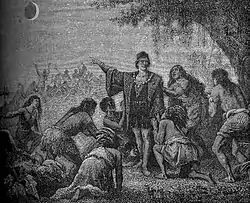
In Panama, Columbus learned from the Ngobe of gold and a strait to another ocean, but was told by local leader Quibían not to go past a certain point down the river. After much exploration, in January 1503, he established a garrison at the mouth of the Belén River. On 6 April, one of the ships became stranded in the river. At the same time, the garrison was attacked by Quibían and the other ships were damaged. Shipworms also damaged the ships in tropical waters.[146]
Columbus left for Hispaniola on 16 April heading north. On 10 May he sighted the Cayman Islands, naming them "Las Tortugas" after the numerous sea turtles there.[147] His ships next sustained more damage in a storm off the coast of Cuba.[147] Unable to travel farther, on 25 June 1503 they were beached in St. Ann's Bay, Jamaica.[148]
For one year Columbus and his men remained stranded on Jamaica. A Spaniard, Diego Méndez, and some natives paddled a canoe to get help from Hispaniola. The governor, Nicolás de Ovando y Cáceres, detested Columbus and obstructed all efforts to rescue him and his men. In the meantime Columbus, in a desperate effort to induce the natives to continue provisioning him and his hungry men, won their favor by predicting a lunar eclipse for 29 February 1504, using Abraham Zacuto's astronomical charts.[149][150][151] Help finally arrived, no thanks to the governor, on 29 June 1504, and Columbus and his men arrived in Sanlúcar, Spain, on 7 November.
Later life, illness, and death
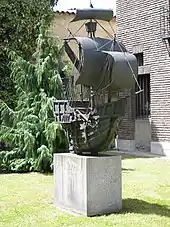
Columbus had always claimed the conversion of non-believers as one reason for his explorations, but he grew increasingly religious in his later years. Probably with the assistance of his son Diego and his friend the Carthusian monk Gaspar Gorricio, Columbus produced two books during his later years: a Book of Privileges (1502), detailing and documenting the rewards from the Spanish Crown to which he believed he and his heirs were entitled, and a Book of Prophecies (1505), in which he considered his achievements as an explorer but a fulfillment of Bible prophecy in the context of Christian eschatology.[8][153]
In his later years, Columbus demanded that the Spanish Crown give him 10 percent of all profits made in the new lands, as stipulated in the Capitulations of Santa Fe. Because he had been relieved of his duties as governor, the crown did not feel bound by that contract and his demands were rejected. After his death, his heirs sued the Crown for a part of the profits from trade with America, as well as other rewards. This led to a protracted series of legal disputes known as the pleitos colombinos ("Columbian lawsuits").
During a violent storm on his first return voyage, Columbus, then 41, suffered an attack of what was believed at the time to be gout. In subsequent years, he was plagued with what was thought to be influenza and other fevers, bleeding from the eyes, temporary blindness and prolonged attacks of gout. The attacks increased in duration and severity, sometimes leaving Columbus bedridden for months at a time, and culminated in his death 14 years later.
Based on Columbus's lifestyle and the described symptoms, modern doctors suspect that he suffered from reactive arthritis, rather than gout.[155][156] Reactive arthritis is a joint inflammation caused by intestinal bacterial infections or after acquiring certain sexually transmitted diseases (primarily chlamydia or gonorrhea). "It seems likely that [Columbus] acquired reactive arthritis from food poisoning on one of his ocean voyages because of poor sanitation and improper food preparation," writes Dr. Frank C. Arnett, a rheumatologist and professor of internal medicine, pathology and laboratory medicine the University of Texas Medical School at Houston.[155]
On 20 May 1506, aged 54, Columbus died in Valladolid, Spain.[157]
Location of remains
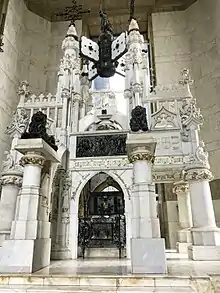
Columbus's remains were first buried at a convent in Valladolid,[158] then moved to the monastery of La Cartuja in Seville (southern Spain) by the will of his son Diego. They may have been exhumed in 1513 and interred at the Cathedral of Seville.[158] In about 1536, the remains of both Columbus and his son Diego were moved to a cathedral in Colonial Santo Domingo, in the present-day Dominican Republic.[158] By some accounts, around 1796, when France took over the entire island of Hispaniola, Columbus's remains were moved to Havana, Cuba.[158] After Cuba became independent following the Spanish–American War in 1898, the remains were moved back to the Cathedral of Seville, Spain,[158] where they were placed on an elaborate catafalque. In June 2003, DNA samples were taken from these remains[159][lower-alpha 18] as well as those of Columbus's brother Diego and younger son Fernando. Initial observations suggested that the bones did not appear to match Columbus's physique or age at death.[161] DNA extraction proved difficult; only short fragments of mitochondrial DNA could be isolated. These matched corresponding DNA from Columbus's brother, supporting that both individuals had shared the same mother.[162] Such evidence, together with anthropologic and historic analyses, led the researchers to conclude that the remains belonged to Christopher Columbus.[163]
In 1877, a priest discovered a lead box at Santo Domingo inscribed: "Discoverer of America, First Admiral". Inscriptions found the next year read "Last of the remains of the first admiral, Sire Christopher Columbus, discoverer."[164] The box contained bones of an arm and a leg, as well as a bullet.[lower-alpha 19] These remains were considered legitimate by physician and U.S. Assistant Secretary of State John Eugene Osborne, who suggested in 1913 that they travel through the Panama Canal as a part of its opening ceremony.[166][lower-alpha 20] These remains were kept at the Basilica Cathedral of Santa María la Menor before being moved to the Columbus Lighthouse (inaugurated in 1992). The authorities in Santo Domingo have never allowed these remains to be exhumed, so it is unconfirmed whether they are from Columbus's body as well.[162][163][lower-alpha 21]
Commemoration
The anniversary of Columbus's 1492 landing in the Americas is usually observed on 12 October in Spain and throughout the Americas, except Canada. In Spain it is called the Fiesta Nacional de España y Día de la Hispanidad commemorating the role of Spain in world history, while a number of countries in Latin America celebrate it as Día de la Raza commemorating their common heritage. In the United States it is called Columbus Day and is observed annually on the second Monday in October. It was promoted by Italian-Americans to place themselves as part of the history of the U.S. among discrimination against Italians and Catholics.[168] There are efforts in the U.S. to replace Columbus Day with Indigenous Peoples' Day.

For the nascent United States, other European explorers such as the Venetian John Cabot made poor objects of commemoration due to their ties to Britain, which was the nation that the Americans had fought against for their independence.[169] American nativists preferred Leif Erikson.[168] Veneration of Columbus in America dates back to colonial times. The name Columbia for "America" first appeared in a 1738 weekly publication of the debates of the British Parliament.[170] The use of Columbus as a founding figure of New World nations and the use of the word "Columbia", or simply the name "Columbus", spread rapidly after the American Revolution. This was out of a desire to develop a national history and founding myth with fewer ties to Britain.[171] Columbus's name was given to the federal capital of the U.S. (District of Columbia), the capital cities of two U.S. states (Ohio and South Carolina), and the Columbia River. Outside the United States the name was used in 1819 for the Gran Colombia, a precursor of the modern Republic of Colombia. Numerous cities, towns, counties, streets, and plazas (called Plaza Colón or Plaza de Colón throughout Latin America and Spain) have been named after him. A candidate for sainthood in the Catholic Church in 1866, celebration of Columbus's legacy perhaps reached a zenith in 1892 with the 400th anniversary of his first arrival in the Americas. Monuments like the Columbus Circle in New York City were erected throughout the United States and Latin America extolling him. The Knights of Columbus is a fraternal organization for Catholic men founded in 1882. While its initial membership was mainly Irish, they took Columbus as a symbol of Catholicism in America.[168] The World's Columbian Exposition in Chicago, 1893, commemorated the 400th anniversary of the landing of Christopher Columbus in the Americas.[172] Over 27 million people attended the exposition during its six-month duration.[173]

.jpg.webp)
The United States Postal Service participated in the celebration issuing the first U.S. commemorative stamps, a series of 16 postage issues called the Columbian Issue depicting Columbus, Queen Isabella and others in the various stages of his several voyages. The issues range in value from the 1-cent to the 5-dollar denominations. Under Benjamin Harrison and his Postmaster General John Wanamaker the Columbian commemorative stamps were made available and were first issued at the World Columbian Exposition in Chicago in 1893. Wanamaker originally introduced the idea of issuing the nation's first commemorative stamp to Harrison, the Congress and the U.S. Post Office. To demonstrate his confidence in the new Columbian commemorative issues Wanamaker purchased $10,000 worth of stamps with his own money. The Columbian Exposition lasted several months, and over $40 million in commemorative postage stamps had been sold.[174] The 400th anniversary Columbian issues were very popular in the United States. A total of two billion stamps were issued for all the Columbian denominations, and 72 percent of these were the two-cent stamps, "Landing of Columbus", which paid the first-class rate for domestic mail at the time.[175]
In 1992, a second Columbian issue was released that was identical to the first to commemorate the 500th anniversary, except for the date in the upper right hand corner of each stamp. These issues were made from the original dies of which the first engraved issues of 1893 were produced. The United States issued the series jointly for the first time with three other countries, Italy in lire, Portugal in escudos and Spain in pesetas.[176]
In 1909, descendants of Columbus undertook to dismantle the Columbus family chapel in Spain and move it to Boalsburg near State College, Pennsylvania, where it may now be visited by the public.[177] At the museum associated with the chapel, there are a number of Columbus relics worthy of note, including the armchair that the "Admiral of the Ocean Sea" used at his chart table.
Legacy
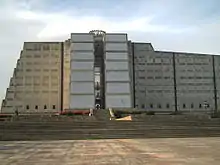
Columbus's voyages are considered some of the most important events in world history, kickstarting modern globalism and resulting in major demographic, commercial, economic, social, and political changes.[179][180] These explorations resulted in the permanent contact between the two hemispheres. There was a massive exchange of animals, plants, fungi, diseases, technologies, mineral wealth and ideas.[181][182][183][184] Exposed to old world diseases, the indigenous populations of the New world collapsed and were largely replaced by Europeans and Africans who brought with them new methods of farming, business, governance, and religious worship.[185][186]
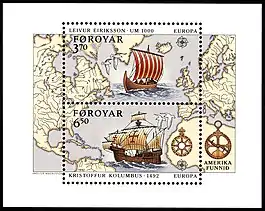
Though Christopher Columbus came to be considered the discoverer of America in U.S. and European popular culture, his historical legacy is more nuanced. America had first been discovered and populated by Asians crossing Beringia (its indigenous population), and the first Europeans to reach its shores were Erik the Red in 10th-century Greenland and his son Leif Erikson in 11th-century Vinland at L'Anse aux Meadows.[187][188] Columbus's efforts brought the Americas to the attention of Europe at a time ripe for Europe to act upon. Thus, Columbus was able to initiate the enduring association between the Earth's two major landmasses and their inhabitants. "Columbus's claim to fame isn't that he got there first," explains Martin Dugard, "it's that he stayed."[189]
Flat Earth mythology
Washington Irving's 1828 biography of Columbus popularized the idea that Columbus had difficulty obtaining support for his plan because many Catholic theologians insisted that the Earth was flat,[190] but this is a popular misconception which can be traced back to 17th-century Protestants campaigning against Catholicism.[191] In fact, the spherical shape of the Earth had been known to scholars since antiquity, and was common knowledge among sailors, including Columbus.[192] Coincidentally, the oldest surviving globe of the Earth, the Erdapfel, was made in 1492, just before Columbus's return to Europe. As such it contains no sign of the Americas and yet demonstrates the common belief in a spherical Earth.[193]
On his third voyage, Columbus formulated a new model of the Earth shortly after observing that the North Star is not fixed. Making observations with a quadrant, he "regularly saw the plumb line fall to the same point," instead of moving along as his ship moved. He divined that he had discovered the entrance to Heaven, from which Earth's waters extend, the planet forming a pear-shape with the insurmountable "stalk" portion of the pear pointing towards Heaven.[192] In fact, the Earth ever so slightly is pear-shaped, with the "stalk" pointing North.[194]
America as a distinct land
_-_DSC05924.JPG.webp)
Historians have traditionally argued that Columbus remained convinced until his death that his journeys had been along the east coast of Asia as he originally intended,[195][171] but writer Kirkpatrick Sale argues that a document in the Book of Privileges indicates Columbus knew he found a new continent.[196] Furthermore, his journals from the third voyage call the "land of Paria" a "hitherto unknown" continent.[197] On the other hand, his other writings continued to claim that he had reached Asia, such as a 1502 letter to Pope Alexander VI where he asserted that Cuba was the east coast of Asia.[198] He also rationalized that the new continent of South America was the "Earthly Paradise" that was located "at the end of the Orient".[197]
The term "pre-Columbian" is usually used to refer to the peoples and cultures of the Americas before the arrival of Columbus and his European successors.
Criticism and defense
Columbus is both criticized for his alleged brutality and initiating the depopulation of the indigenous Americans, whether by disease or intentional genocide. Some defend his alleged actions or say the worst of them are not based in fact.
As a result of both the protests and riots that followed the killing of George Floyd in 2020, many public monuments of Christopher Columbus began to be removed.[199]
Brutality
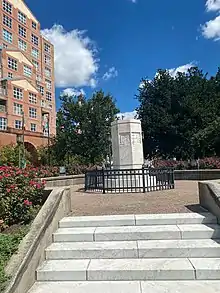
Historians have criticized Columbus for initiating colonization and for abuse of natives.[200][79][201][202] On St. Croix, Columbus let his friend Michele da Cuneo keep an indigenous woman he captured, then, by his own account, brutally raped her.[98] Tony Horwitz notes that this is the first recorded instance of sexuality between a European and Native American.[203] The punishment for an indigenous person failing to fill their hawk's bell of gold dust every three months was cutting off the hands of those without tokens, letting them bleed to death.[79][204] Thousands of natives are thought to have committed suicide by poison to escape their persecution.[111] The neutrality and accuracy of Bobadilla's 48-page report accusing Columbus and his brothers of using torture and mutilation to govern Hispaniola have been disputed by historians, given the anti-Italian sentiment of the Spaniards and Bobadilla's desire to take over Columbus' position.[205][206][207] Consuelo Varela, a Spanish historian who has seen the report, states that "Columbus's government was characterised by a form of tyranny. Even those who loved him had to admit the atrocities that had taken place."[140]
Some accounts of the alleged brutality of Columbus and his brothers may be part of the Black Legend, an alleged intentional defamation of Spain,[208][209][210] while others challenge the genocide narrative.[106][211] Some historians have argued that, while brutal, Columbus was simply a product of his time, and being a figure of the 15th century, should not be judged by the morality of the 20th century.[212] Others openly defend colonization. Spanish ambassador María Jesús Figa López-Palop claims, "Normally we melded with the cultures in America, we stayed there, we spread our language and culture and religion."[213] Horwitz asserts that paternalistic attitudes were often characteristic of the colonists themselves.[214]
Depopulation
Modern estimates for the pre-Columbian population of Hispaniola vary from ten thousand[215] to more than a million.[123] Some estimate that a third or more of the natives in Haiti were dead within the first two years of Columbus's governorship,[79][111] many from lethal forced labour in the mines, in which a third of workers died every six months.[216] Within three decades, the surviving Arawak population numbered only in the hundreds;[216] "virtually every member of the gentle race ... had been wiped out."[111] Indirect evidence suggests that some serious illness may have arrived with the 1,500 colonists who accompanied Columbus's second expedition in 1493.[214] Charles C. Mann writes that "It was as if the suffering these diseases had caused in Eurasia over the past millennia were concentrated into the span of decades."[217] According to the historian Gonzalo Fernández de Oviedo y Valdés, by 1548, 56 years after Columbus landed, and 42 years after he died, fewer than 500 Taíno were living on the island.[218] The indigenous population was reduced by some 90% overall in the century following Columbus's arrival.[219] Disease, warfare and harsh enslavement contributed to the depopulation.[214][220][221][222] Within indigenous circles, Columbus is often viewed as a key agent of genocide.[223] Samuel Eliot Morison, a Harvard historian and author of a multivolume biography on Columbus, writes, "The cruel policy initiated by Columbus and pursued by his successors resulted in complete genocide."[224]
According to Noble David Cook, "There were too few Spaniards to have killed the millions who were reported to have died in the first century after Old and New World contact". He instead estimates that the death toll was caused by smallpox,[225] the first pandemic of European endemic diseases, which struck Hispaniola after the arrival of Hernán Cortés in 1519.[226][227] According to some estimates, smallpox had an 80–90% fatality rate in Native American populations.[228] The natives had no acquired immunity to these new diseases and suffered high fatalities. There is also evidence that they had poor diets and were overworked.[107][229][230] Historian Andrés Reséndez of University of California, Davis, says the available evidence suggests "slavery has emerged as major killer" of the indigenous populations of the Caribbean between 1492 and 1550 more so than diseases such as smallpox, influenza and malaria.[231] He says that indigenous populations did not experience a rebound like European populations did following the Black Death because unlike the latter, the former were subjected to deadly forced labour in gold and silver mines on a massive scale.[232] The diseases that devastated the Native Americans came in multiple waves at different times, sometimes as much as centuries apart, which would mean that survivors of one disease may have been killed by others, preventing the population from recovering.[233]
Navigational expertise
Biographers and historians have a wide range of opinions over Columbus's expertise and experience navigating and captaining ships. One scholar lists some European works ranging from the 1890s to 1980s that support Columbus's experience and skill as among the best in Genoa, while listing some American works over a similar timeframe that portray the explorer as an untrained entrepreneur, having only minor crew or passenger experience prior to his noted journeys.[234]
Physical appearance
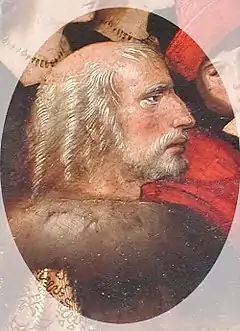
Contemporary descriptions of Columbus, including those by his son Ferdinand and Las Casas, describe him as taller than average, with light skin (which was often sunburnt), blue or hazel eyes, high cheekbones and freckled face, an aquiline nose, and blond to reddish hair and beard (until about the age of 30, when it began to whiten).[235][236] Although an abundance of artwork depicts Christopher Columbus, no authentic contemporary portrait is known.[237]
The most iconic image of Columbus is a portrait by Sebastiano del Piombo, which has been reproduced in many textbooks. It agrees with descriptions of Columbus in that it shows a large man with auburn hair, but the painting dates from 1519 and cannot, therefore, have been painted from life. Furthermore, the inscription identifying the subject as Columbus was probably added later, and the face shown differs from other images.[238]
Sometime between 1531 and 1536, Alejo Fernández painted an altarpiece, The Virgin of the Navigators, that includes a depiction of Columbus. The painting was commissioned for a chapel in Seville's Casa de Contratación (House of Trade) and remains there, as the earliest known painting about the voyages of Columbus.[239][240]
At the World's Columbian Exposition in 1893, 71 alleged portraits of Columbus were displayed; most did not match contemporary descriptions.[241]
Notes
- In other relevant languages:
- "Even with less than a complete record, however, scholars can state with assurance that Columbus was born in the republic of Genoa in northern Italy, although perhaps not in the city itself, and that his family made a living in the wool business as weavers and merchants. ... The two main early biographies of Columbus have been taken as literal truth by hundreds of writers, in large part because they were written by individuals closely connected to Columbus or his writings. ... Both biographies have serious shortcomings as evidence." (Phillips, Jr & Phillips 1992, p. 9)
- About 10,600 nautical miles
- Ferdinand later claimed credit for being "the principal cause why those islands were discovered."[57]
- Felipe Fernández-Armesto points out that Columbus briefly described South America as an unknown continent after seeing the mainland for the first time. Vespucci seems to have modeled his naming of the "new world" after Columbus's description of this discovery. Further, mapmaker Martin Waldseemüller eventually retracted his naming of the continent after Vespucci, seemingly after it came to light that a claim that Vespucci visited the mainland before Columbus had been falsified. In his new map, Waldseemüller labelled the continent as Terra Incognita ('unknown land'), noting that it had been discovered by Columbus.[60]
- This map is based on the premise that Columbus first landed at Plana Cays.[61] The island considered by Samuel Eliot Morison to be the most likely location of first contact[62] is the easternmost land touching the top edge of this image.
- Shen Kuo discovered 400 years earlier, in Asia, the concept of true north in terms of magnetic declination towards the north pole, with experimentation of suspended magnetic needles and "the improved meridian determined by Shen's [astronomical] measurement of the distance between the polestar and true north".[67]
- Two others thought that they saw such a light, one independently from Columbus. The strong winds and the fact that they were some 56 kilometres (35 mi) from land indicate that this was unlikely from a native inhabitant fishing.[69]
- According to Samuel Eliot Morison, San Salvador Island, renamed from Watling's Island in 1925 in the belief that it was Columbus's San Salvador,[74] is the only island fitting the position indicated by Columbus's journal. Other candidates are the Grand Turk, Cat Island, Rum Cay, Samana Cay, or Mayaguana.[62]
- Torres spoke Hebrew and some Arabic; the latter was then believed to be the mother tongue of all languages.[82]
- He wrote,
While I was in the boat, I captured a very beautiful Carib woman, whom the said Lord Admiral gave to me. When I had taken her to my cabin she was naked—as was their custom. I was filled with a desire to take my pleasure with her and attempted to satisfy my desire. She was unwilling, and so treated me with her nails that I wished I had never begun. But—to cut a long story short—I then took a piece of rope and whipped her soundly, and she let forth such incredible screams that you would not have believed your ears. Eventually we came to such terms, I assure you, that you would have thought that she had been brought up in a school for whores.[99]
- Amerigo Vespucci was an associate of Berardi.[113]
- Berardi became unwell in December, and recorded that Columbus still owed him 180,000 maravedís for his contributions. He also left his daughter to the admiral's care, calling him "his lordship", although it is unknown what became of her.[114]
- The hawk's bells were to be filled with gold every three months.[111]
- The tribute system had all but collapsed by 1497.[121]
- King John reportedly knew of the existence of such a mainland because "canoes had been found which set out from the coast of Guinea [West Africa] and sailed to the west with merchandise."[125][126]
- Bobadilla's 48-page report, derived from the testimonies of 23 people who had seen or heard about the treatment meted out by Columbus and his brothers—had originally been lost for centuries, but was rediscovered in 2005 in the Spanish archives in Valladolid. It contained an account of Columbus's seven-year reign as the first governor of the Indies. Consuelo Varela, a Spanish historian, states: "Even those who loved him [Columbus] had to admit the atrocities that had taken place."[140]
- According to Professor Miguel Patella of the University of Granada, who was present the last time Columbus's crypt was opened, these include part of a jaw and an arm, as well as a couple of leg bones and vertebrae.[160]
- This same year, dust collected from these remains was placed in a locket, which was placed inside the stern of a silver model caravel. Two tiny portions of dust from the same source were placed in separate vials.[165]
- Osborne cited the bullet as evidence the remains belonged to Columbus,[166] but its significance is unclear.[164]
- These remains are displayed in their crypt (behind a sheet of glass) once a year on Columbus Day.[167]
References
- Lester, Paul M. (January 1993). "Looks are deceiving: The portraits of Christopher Columbus". Visual Anthropology. 5 (3–4): 211–227. doi:10.1080/08949468.1993.9966590.
- Gilman, D. C.; Peck, H. T.; Colby, F. M., eds. (1905). . New International Encyclopedia (1st ed.). New York: Dodd, Mead. – The names Giacomo and Diego are cognates, along with James, all sharing a common origin. See Behind the Name, Mike Campbell, pages Giacomo, Diego, and James. All retrieved 3 February 2017.
- "Columbus". Random House Webster's Unabridged Dictionary.
- Beazley 1911, p. 741.
- Morison 1991, p. 7.
- Phillips, Jr & Phillips 1992, p. 9.
- Bergreen 2011, p. 56.
- Encyclopædia Britannica, 1993 ed., Vol. 16, pp. 605ff / Morison, Christopher Columbus, 1955 ed., pp. 14ff
- Rime diverse, Pavia, 1595, p. 117
- Tasso, Torquato (1755). Ra Gerusalemme deliverâ. Genoa: Ra Stamparia de Tarigo. p. 32. Retrieved 2 February 2012.
- Çittara zeneize – Regole d'Ortografia, Genoa, 1745
- Consulta ligure, Vocabolario delle parlate liguri, Sage, 1982, ISBN 88-7058-044-X
- Govan, Fiona (14 October 2009). "Christopher Columbus writings prove he was Spanish, claims study". The Telegraph.
- (in Portuguese) "Armas e Troféus." Revista de História, Heráldica, Genealogia e Arte. 1994 - VI serie — Tomo VI — pp. 5-52. Retrieved 21 November 2011.
- Davidson 1997, p. 3.
- Phillips, Jr & Phillips 1992, p. 85.
- "Christopher Columbus". Archived from the original (PDF) on 23 March 2002.. Thomas C. Tirado, PhD Professor History. Millersville University.
- "It is most probable that Columbus visited Bristol, where he was introduced to English commerce with Iceland." Bedini, Silvio A. and David Buisseret (1992). The Christopher Columbus encyclopedia, Volume 1, University of Michigan Press, republished by Simon & Schuster, ISBN 0-13-142670-2, p. 175
- Morison 1991, pp. 25–26.
- Anne Paolucci and Henry Paolucci (1992). Columbus, America, and the World, p. 140. "Many Columbists ... have doubted that Columbus could ever have gone to Iceland."
- Freitas, Antonio Maria de (1893). The Wife of Columbus: With Genealogical Tree of the Perestrello and Moniz Families. New York: Stettinger, Lambert & Co.
- "Christopher Columbus (Italian explorer)". Encyclopædia Britannica Online.
- Dyson 1991, p. 63.
- Paolo Emilio Taviani, "Beatriz Arana" in The Christopher Columbus Encyclopedia, vol. 1, p. 24. New York: Simon and Schuster 1992.
- "Christopher Columbus Biography". Columbus-day.123holiday.net. p. 2. Retrieved 29 July 2009.
- Taviani, "Beatriz Arana" in The Christopher Columbus Encyclopedia, vol. 1, pp. 24–25.
- Morgan, Edmund S. (October 2009). "Columbus' Confusion About the New World". Smithsonian Magazine.
- Delaney, Carol (8 March 2006). "Columbus's Ultimate Goal: Jerusalem" (PDF). Comparative Studies in Society and History. 48 (2): 260–292. doi:10.1017/S0010417506000119. JSTOR 3879352. S2CID 144148903.
- Sheehan, Kevin Joseph (2008). Iberian Asia: the strategies of Spanish and Portuguese empire building, 1540-1700 (Thesis). OCLC 892835540. ProQuest 304693901.
- Hamdani, Abbas (1979). "Columbus and the Recovery of Jerusalem". Journal of the American Oriental Society. 99 (1): 39–48. doi:10.2307/598947. JSTOR 598947.
- Jeakle, Will (11 October 2020). "Six Things You Didn't Know About Christopher Columbus". Forbes. Retrieved 14 October 2020.
- Charles R. Boxer (1951). The Christian Century in Japan: 1549–1650. University of California Press. p. 2. Retrieved 28 February 2016.
- Morison 1991, pp. 63–64.
- Journal article: Christopher Columbus. An address delivered before the American Catholic Historical Society
- Murphy & Coye 2013.
- Russell, Jeffrey Burton 1991. Inventing the Flat Earth. Columbus and modern historians, Praeger, New York, Westport, London 1991.
- Zinn 2003, p. 2.
- See, e.g. "Mariner's Astrolabe", Navigation Museum, Institute of Navigation
- Ridpath, Ian (2001). The Illustrated Encyclopedia of the Universe. New York, NY: Watson-Guptill. p. 31. ISBN 978-0-8230-2512-1.
- Sagan, Carl. Cosmos; the mean circumference of the Earth is 40,041.47 km (24,881 mi).
- Freely, John (2013). Before Galileo: The Birth of Modern Science in Medieval Europe. New York: Abrams. p. 36. ISBN 978-1-4683-0850-1.
- "Marco Polo et le Livre des Merveilles", p. 37. ISBN 978-2-35404-007-9
- Morison (1942, pp. 65, 93).
- Morison 1991, p. 68.
- Dyson 1991, pp. 67–68.
- Morison 1991.
- Phillips, Jr & Phillips 1992, p. 110.
- Jensen, De Ladickmar (1992), Renaissance Europe 2nd ed. p. 341
- Dyson 1991, pp. 67, 69.
- Morison 1991, pp. 68–70.
- Dyson 1991, pp. 84–85.
- The Brooklyn Museum catalogue notes that the most likely source for Leutze's trio of Columbus paintings is Washington Irving's best-selling Life and Voyages of Columbus (1828).
- Dyson 1991, p. 84.
- Durant, Will The Story of Civilization vol. vi, "The Reformation". Chapter XIII, p. 260.
- Dyson 1991, pp. 86, 92.
- Dyson 1991, p. 92.
- Phillips, Jr & Phillips 1992, pp. 131–32.
- Mark McDonald, "Ferdinand Columbus, Renaissance Collector (1488–1539)", 2005, British Museum Press, ISBN 978-0-7141-2644-9
- "The Naming of America". Umc.sunysb.edu. Archived from the original on 29 October 2013. Retrieved 10 April 2011.
- Fernández-Armesto, Felipe (2007). Amerigo: The Man Who Gave His Name to America (1st ed.). New York: Random House. pp. 143–44, 186–87. ISBN 978-1-4000-6281-2. OCLC 608082366.
- Pickering, Keith A. (August 1994). "Columbus's Plana landfall: Evidence for the Plana Cays as Columbus's 'San Salvador'" (PDF). DIO – the International Journal of Scientific History. 4 (1): 13–32. Retrieved 16 March 2009.
- Morison 1991, p. 228.
- Dyson 1991, p. 102.
- "The Original Niña". The Niña & Pinta. British Virgin Islands: The Columbus Foundation. Archived from the original on 26 May 2015. Retrieved 12 October 2013.
- Phillips Jr & Phillips 1993, pp. 146–47.
- Peter J. Smith & Joseph Needham, "Magnetic Declination in Mediaeval China", Nature 214, 1213–1214 (17 June 1967); doi:10.1038/2141213b0.
- Sivin, Nathan (1984). "Why the Scientific Revolution Did Not Take Place in China – Or Didn't It?" in Transformation and Tradition in the Sciences: Essays in Honor of I. Bernard Cohen, 531–555, ed. Everett Mendelsohn. Cambridge: Cambridge University Press. ISBN 0-521-52485-7. Vol. III, p. 22.
- Nicholls, Steve (2009). Paradise Found: Nature in America at the Time of Discovery. Chicago: University of Chicago Press. pp. 103–104. ISBN 978-0-226-58340-2.
- Morison 1991, pp. 223–225.
- Morison 1991, p. 226.
- Lopez, (1990, p. 14); Columbus & Toscanelli (2010, p. 35)
- Lopez, (1990, p. 15)
- Bergreen 2011, p. 99.
- William D. Phillips Jr., 'Columbus, Christopher', in David Buisseret (ed.), The Oxford Companion to World Exploration, (Oxford: Oxford University Press, online edition 2012).
- Robert H. Fuson, ed., The Log of Christopher Columbus, Tab Books, 1992, International Marine Publishing, ISBN 0-87742-316-4.
- Hoxie, Frederick (1996). Encyclopedia of North American Indians. Boston: Houghton Mifflin Co. p. 568. ISBN 978-0-395-66921-1.
- Herbst, Philip (1997). The Color of Words: An Encyclopaedic Dictionary of Ethnic Bias in the United States. Intercultural Press. p. 116. ISBN 978-1-877864-97-1. Retrieved 28 February 2016.
- Wilton, David (2004). Word Myths: Debunking Linguistic Urban Legends. Oxford University Press. pp. 164–165. ISBN 978-0-19-517284-3.
- Zinn 2003, pp. 1–22
- Columbus (1991, p. 87). Or "these people are very simple as regards the use of arms … for with fifty men they can all be subjugated and made to do what is required of them." (Columbus & Toscanelli, 2010, p. 41)
- Keith A. Pickering. "The First Voyage of Columbus". Archived from the original on 7 March 2012.
- Morison 1991, p. 145.
- Maclean, Frances (January 2008). "The Lost Fort of Columbus". Smithsonian Magazine. Retrieved 24 January 2008.
- Fuson, Robert. The Log of Christopher Columbus (Camden, International Marine, 1987) 173.
- Yewell, John; Chris Dodge (1992). Confronting Columbus: An Anthology. Jefferson, NC: McFarland & Company. p. 33. ISBN 978-0-89950-696-8. Retrieved 28 February 2016.
- Markham, Clements R. (1893). The Journal of Christopher Columbus. London: Hakluyt Society. pp. 159–160. Retrieved 28 February 2016.
- Oliver Dunn and James Kelly. The Diario of Christopher Columbus's First Voyage to America (London: University of Oklahoma Press), 333–343.
- Catz, Rebecca (1 January 1990). "Columbus in the Azores". Portuguese Studies. 6: 17–23. JSTOR 41104900.
- Morison 1991, p. 381.
- Diffie, Bailey Wallys (1977). Foundations of the Portuguese Empire, 1415–1580. Winius, George D. Minneapolis: University of Minnesota Press. p. 173. ISBN 0-8166-0782-6. OCLC 3488742.
- Baccus, M. Kazim Utilization, Misuse, and Development of Human Resources in the Early West Indian Colonies, Wilfrid Laurier University Press (2 January 2000) ISBN 978-0-88920-982-4 pp. 6–7
- Lydersen, Kari (18 May 2009). "Dental Studies Give Clues About Christopher Columbus's Crew". The Washington Post.
- Felipe Fernández-Armesto, Columbus, Oxford Univ. Press, (1991) pp. 103–104
- Paolo Emilio Taviani, Columbus the Great Adventure, Orion Books, New York (1991) p. 185
- Traboulay, David M. (1994). Columbus and Las Casas. University Press of America. p. 48. ISBN 978-0-8191-9642-2. Retrieved 28 February 2016.
- "Saint Croix | island, United States Virgin Islands". Encyclopedia Britannica. Retrieved 5 January 2019.
- Phillips, Jr & Phillips 1992, pp. 197–98.
- Morison 1991, p. 417.
- Cohen, J.M. (1969). The Four Voyages of Christopher Columbus. NY: Penguin. p. 139. ISBN 978-0-14-044217-5.
- Phillips, Jr & Phillips 1992, p. 198.
- Phillips, Jr & Phillips 1992, p. 197.
- Antonio de la Cova. "The Spanish Conquest of the Tainos". Latin American Studies. Dr. Antonio Rafael de la Cova. Retrieved 10 July 2011.
- "Teeth Of Columbus's Crew Flesh Out Tale Of New World Discovery". ScienceDaily. 20 March 2009.
- Colón, Fernando (1976). "61 'How the Admiral Completed the Conquest of Española, and What He Did to Make It Yield Revenue'". The Life of the Admiral Christopher Columbus by His Son, Ferdinand. Translated by Keen, Benjamin. Folio Society. Retrieved 16 October 2019.
- Horwitz 2008, p. 70.
- Lane, Kris (8 October 2015). "Five myths about Christopher Columbus". The Washington Post. Retrieved 4 August 2018.
- Austin Alchon, Suzanne (2003). A Pest in the Land: New World Epidemics in a Global Perspective. University of New Mexico Press. p. 62. ISBN 978-0-8263-2871-7. Retrieved 28 February 2016.
- Alfred W. Crosby, The Columbian Exchange, Westport, 1972, pp. 39, 45, 47.
- Cook, Noble David (1998). Born to Die: Disease and the New World Conquest. Cambridge: Cambridge University Press. p. 202.
- Morison 1991, pp. 482–85.
- Dyson 1991, pp. 183, 190.
- Montague, Peter. "Celebrating Columbus Day". The Ecologist. Dec. 1999: 468–470. SIRS Issues Researcher. Web. 22 Feb. 2016.
- Arciniegas, Germán (1955). Amerigo and the New World: The Life and Times of Amerigo Vespucci. Translated by de Onís, Harriet. New York: Alfred A. Knopf. pp. 98, 102. ISBN 0-374-90280-1.
- Fernández-Armesto, Felipe (2007). Amerigo: The Man Who Gave His Name to America. New York: Random House. pp. 54–55. ISBN 978-1-4000-6281-2.
- Yeager, Timothy J. (3 March 2009). "Encomienda or Slavery? The Spanish Crown's Choice of Labor Organization in Sixteenth-Century Spanish America". The Journal of Economic History. 55 (4): 842–859. doi:10.1017/S0022050700042182. JSTOR 2123819.
- Lyle N. McAlister (1984). Spain and Portugal in the New World, 1492–1700. University of Minnesota Press. p. 164. ISBN 0-8166-1218-8.
- Olson, Julius E. and Edward G. Bourne (editors). "The Northmen, Columbus and Cabot, 985–1503", in The Voyages of the Northmen; The Voyages of Columbus and of John Cabot. (New York: Charles Scribner's Sons, 1906), pp. 369–383.
- Delaney, Carol (2011). Columbus and the Quest for Jerusalem. Simon and Schuster. p. 162.
- Zinn 2003, p. 3.
- Koning, Hans. Columbus, His Enterprise: Exploding the Myth. New York: Monthly Review Press, 1976: 83-83.
- Deagan, Kathleen A.; Cruxent, José María (2008). Columbus's Outpost Among the Taínos: Spain and America at La Isabela, 1493–1498. New Haven, CT: Yale University Press. p. 62. ISBN 978-0-300-13389-9.
- Stannard, David E. (1993). American Holocaust: The Conquest of the New World. Oxford University Press. p. 69. ISBN 978-0-19-508557-0. Retrieved 21 November 2018.
- Keegan, William F., "Destruction of the Taino" in Archaeology. January/February 1992, pp. 51–56.
- Stannard, David E. (1993). American Holocaust: The Conquest of the New World. Oxford University Press. p. 70. ISBN 978-0-19-508557-0. Retrieved 1 May 2015.
- Morison, Samuel Eliot (1963). Journals & Other Documents on the Life & Voyages of Christopher Columbus. New York: The Heritage Press. pp. 262–263.
- Thacher, John Boyd (1903). Christopher Columbus: his life, his work, his remains, as revealed by original printed and manuscript records, together with an essay on Peter Martyr of Anghera and Bartolomé De Las Casas, the first Historians of America. New York: G. P. Putnam's Sons. pp. 379–380.
- Christopher Minster, "The Third Voyage of Christopher Columbus"
- Joseph 1838, p. 124
- Joseph 1838, p. 125
- Bergreen 2011, p. 245.
- Joseph 1838, p. 126
- Bergreen 2011, p. 249.
- Bergreen 2011, p. 258.
- "Christopher Columbus Voyage on Tripline". www.tripline.net. Retrieved 5 January 2019.
- Varela, Consuelo; Aguirre, Isabel (2006). "La venta de esclavos" [The sale of slaves]. La caída de Cristóbal Colón: el juicio de Bobadilla [The fall of Christopher Columbus: the Bobadilla trial] (in Spanish). Marcial Pons Historia. pp. 111–118. ISBN 978-84-96467-28-6.
- Stone, Edward T. (1975). "Columbus and Genocide". American Heritage. Vol. 26 no. 6. American Heritage Publishing Company.
- Brink, Christopher. Christopher Columbus: Controversial Explorer of the Americas. p. 78.
- Noble, David Cook. "Nicolás de Ovando" in Encyclopedia of Latin American History and Culture, vol.4, p. 254. New York: Charles Scribner's Sons 1996.
- Bergreen 2011, pp. 276–77.
- Giles Tremlett (7 August 2006). "Lost document reveals Columbus as tyrant of the Caribbean". The Guardian. UK. Retrieved 16 May 2013.
- "Columbus Controversy". A&E Television Networks. Retrieved 12 August 2013.
- Bergreen 2011, p. 281.
- Dugard 2005, p. 149–50.
- Dugard 2005, p. 130.
- Morison 1991, p. 617.
- The History Channel. Columbus: The Lost Voyage.
- Bergreen 2011, p. 330.
- Bergreen 2011, p. 332.
- Joy Jakim, The First Americans: Prehistory – 1600 A History of US Oxford University Press 2005
- Clayton J., Drees, The Late Medieval Age of Crisis and Renewal: 1300–1500 a Biographical Dictionary, 2001, p. 511
- Kadir, Djelal (1992). Columbus and the Ends of the Earth: Europe's Prophetic Rhetoric as Conquering Ideology. University of California Press. pp. 67–68. ISBN 978-0-520-91133-8.
- "Columbus Monuments Pages: Valladolid". Retrieved 3 January 2010.
- Froom 1950, p. 2.
- "Columbus Monuments Pages: Sevilla". Retrieved 3 January 2010.
- "Christopher Columbus Suffered From a Fatal Form of Arthritis" (Press release). University of Maryland School of Medicine. 6 May 2005. Archived from the original on 23 January 2018.
- Hoenig, Leonard J. (1 February 1992). "The Arthritis of Christopher Columbus". Archives of Internal Medicine. 152 (2): 274–277. doi:10.1001/archinte.1992.00400140028008. PMID 1472175.
- Dyson 1991, p. 194.
- Dyson 1991, p. 196.
- History Today August 2003
- "Columbus Unearthed". Expedition Unknown. Travel Channel. 9 December 2015. Event occurs at 37.
- Tremlett, Giles (11 August 2004). "Young bones lay Columbus myth to rest". The Guardian. Retrieved 26 October 2014.
- "DNA verifies Columbus' remains in Spain". MSNBC. Associated Press. 20 May 2006. Archived from the original on 31 October 2013. Retrieved 15 August 2020.
- Álvarez-Cubero, M.J.; Mtnez.-Gonzalez, L.J.; Saiz, M.; Álvarez, J.C.; Lorente, J.A. (June 2010). "Nuevas aplicaciones en identificación genética" [New applications in genetic identification]. Cuadernos de Medicina Forense (in Spanish). 16 (1–2). doi:10.4321/S1135-76062010000100002.
- Bergreen 2011, pp. 363–64.
- Thacher, John Boyd (1904). Christopher Columbus: his life, his works, his remains: as revealed by original printed and manuscript records, together with an essay on Peter Martyr of Anghera and Bartolomé de las Casas, the first historians of America. New York: G. P. Putnam's Sons. pp. 570–73.
- "Columbus Buried In San Domingo?". Evening Star. 17 July 1913. p. 11. Archived from the original on 2 January 2020. Retrieved 15 August 2020 – via Newspapers.com.
- Horwitz 2008, pp. 89–90, 92.
- Appelbaum, Yoni (8 October 2012). "How Columbus Day Fell Victim to Its Own Success". The Atlantic. Retrieved 21 July 2020.
- "The Invention of Christopher Columbus, American Hero". The Nation. 9 October 2017. Retrieved 11 June 2020.
- The Gentleman's Magazine, Vol. 8, June 1738, p. 285.
- Burmila, Edward (9 October 2017). "The Invention of Christopher Columbus, American Hero".
- "Bird's-Eye View of the World's Columbian Exposition, Chicago, 1893". World Digital Library. 1893. Retrieved 17 July 2013.
- Viele, Nico (4 November 2015). "World's Columbian Exposition of 1893 comes alive on computer screens". UCLA. Retrieved 31 August 2020.
- "John Wanamaker, Postmaster General". United States Postal Service. Archived from the original on 9 May 2009. Retrieved 19 January 2011.
- Haimann, Alexander T., "2-cent Landing of Columbus", Arago: people, postage & the post, National Postal Museum online, viewed 18 April 2014.
- "Columbian Exposition Souvenir Sheets", Arago: people, postage & the post, National Postal Museum online, viewed 18 April 2014.
- "Columbus Monuments Pages: Boalsburg". Retrieved 3 January 2010.
- "Columbus Monuments Pages: Santo Domingo". Retrieved 3 January 2010.
- Allen, R.C. (2011). Global economic history: a very short introduction (Vol. 282). Oxford University Press. pp. 16–19.
- Boivin, Nicole; Fuller, Dorian Q; Crowther, Alison (September 2012). "Old World globalization and the Columbian exchange: comparison and contrast". World Archaeology. 44 (3): 452–469. doi:10.1080/00438243.2012.729404. JSTOR 42003541. S2CID 3285807.
- Grennes, T. (2007). The Columbian exchange and the reversal of fortune. Cato J., 27, 91.
- Earle, R. (2012). The columbian exchange. In The Oxford Handbook of Food History (p. 341). Oxford: Oxford University Press.
- Crosby, A.W. (2003). The Columbian exchange: biological and cultural consequences of 1492 (Vol. 2). Greenwood Publishing Group.
- Nunn, Nathan; Qian, Nancy (1 May 2010). "The Columbian Exchange: A History of Disease, Food, and Ideas" (PDF). Journal of Economic Perspectives. 24 (2): 163–188. doi:10.1257/jep.24.2.163. JSTOR 25703506.
- "Columbian Exchange – The Old World Meets The New World". WorldAtlas. Retrieved 6 September 2018.
- Verano, J.W. (1992). Disease and Demography in the Americas. Smithsonian Inst Pr.
- "History – Leif Erikson (11th century)". BBC. Retrieved 12 October 2015.
- Little, Becky (11 October 2015). "Why Do We Celebrate Columbus Day and Not Leif Erikson Day?". National Geographic. Retrieved 12 October 2015.
- Dugard 2005, p. 185.
- Boller, Paul F (1995). Not So!: Popular Myths about America from Columbus to Clinton. New York: Oxford University Press. ISBN 978-0-19-509186-1.
- Hannam, James (18 May 2010). "Science Versus Christianity?". Patheos.com. Retrieved 5 September 2020.
- Bergreen 2011, p. 244.
- Jeffrey Burton Russell (1991). Inventing the Flat Earth: Columbus and modern historians. New York: Praeger. ISBN 978-0-275-95904-3.
- Tyson, Neil deGrasse (2014) [2007]. Death By Black Hole: And Other Cosmic Quandaries (1st ed.). New York: W. W. Norton. p. 52. ISBN 978-0-393-06224-3. OCLC 70265574.
- Thomas F. McIlwraith; Edward K. Muller (2001). North America: the historical geography of a changing continent. Rowman & Littlefield. p. 35. ISBN 978-0-7425-0019-8. Retrieved 28 February 2016.
- Sale, Kirkpatrick (1991). The Conquest of Paradise: Christopher Columbus and the Columbian Legacy, pp. 204–209
- Eviatar Zerubavel (2003). Terra cognita: the mental discovery of America. Transaction Publishers. pp. 90–91. ISBN 978-0-7658-0987-2. Retrieved 28 February 2016.
- Phillips, Jr & Phillips 1992, p. 227.
- Brito, Christopher (25 September 2020). "Dozens of Christopher Columbus statues have been removed since June". CBS News. Retrieved 26 September 2020.
- Bigelow, B. (1992). Once upon a Genocide: Christopher Columbus in Children's Literature.
- Jack Weatherford (20 April 2001). "Examining the reputation of Christopher Columbus". Hartford-hwp.com. Retrieved 29 July 2009.
- "Pre-Columbian Hispaniola – Arawak/Taino Indians". Hartford-hwp.com. 15 September 2001. Retrieved 29 July 2009.
- Horwitz 2008, p. 69.
- Koning, Hans (1976). Columbus. Monthly Review Press. p. 86. ISBN 978-0-85345-600-1. Retrieved 1 May 2015.
- Columbus and Columbia: A Pictorial History of the Man and the Nation : Embracing a Review of Our Country's Progress, a Complete History of America, a New Life of Columbus, and an Illustrated Description of the Great Columbian Exposition. Historical Publishing Company. 1893. p. 263. Retrieved 18 June 2020.
- Dugard 2005, p. 77.
- Carle, Robert (2019). "Remembering Columbus: Blinded by Politics". National Association of Scholars.
- Hanke, Lewis (1 February 1971). "A Modest Proposal for a Moratorium on Grand Generalizations: Some Thoughts on the Black Legend". Hispanic American Historical Review. 51 (1): 112–127. doi:10.1215/00182168-51.1.112. JSTOR 2512616.
- Keen, Benjamin (1 November 1969). "The Black Legend Revisited: Assumptions and Realities". Hispanic American Historical Review. 49 (4): 703–719. doi:10.1215/00182168-49.4.703. JSTOR 2511162.
- Keen, Benjamin (1 May 1971). "The White Legend Revisited: A Reply to Professor Hanke's 'Modest Proposal'". Hispanic American Historical Review. 51 (2): 336–355. doi:10.1215/00182168-51.2.336. JSTOR 2512479.
- Elliott, J. H.; Stannard, David E. (21 October 1993). "American Holocaust". The New York Review of Books. ISSN 0028-7504. Retrieved 4 February 2019.
- Fusco, Mary Ann Castronovo (8 October 2000). "In Person; In Defense Of Columbus". The New York Times. Retrieved 9 August 2018.
- Horwitz 2008, p. 84.
- Horwitz 2008.
- Fernandes, D.M.; Sirak, K.A.; Ringbauer, H. (2020). "A genetic history of the pre-contact Caribbean". Nature. doi:10.1038/s41586-020-03053-2. PMID 33361817.
- Hickel, Jason (2018). The Divide: A Brief Guide to Global Inequality and its Solutions. Windmill Books. p. 70. ISBN 978-1-78609-003-4.
- Mann, Charles C. (2011). 1493: Uncovering the New World Columbus Created. New York: Alfred A. Knopf. p. 12.
- Crosby (1972), The Columbian Exchange, p. 45.
- Koch, Alexander; Brierley, Chris; Maslin, Mark; Lewis, Simon (1 March 2019). "Earth system impacts of the European arrival and Great Dying in the Americas after 1492". Quaternary Science Reviews. 207: 13–36. Bibcode:2019QSRv..207...13K. doi:10.1016/j.quascirev.2018.12.004.
- Alfred W. Crosby, The Columbian Exchange Westport, 1972, p. 47.
- Abbot 2010.
- Chrisp 2006, p. 34.
- Schuman, H.; Schwartz, B.; D'Arcy, H. (28 February 2005). "Elite Revisionists and Popular Beliefs: Christopher Columbus, Hero or Villain?" (PDF). Public Opinion Quarterly. 69 (1): 2–29. doi:10.1093/poq/nfi001. S2CID 145447081.
- Morison, Samuel Eliot (1955). Christopher Columbus, Mariner. Little Brown & Co (T); First edition. ISBN 978-0-316-58356-5.
- Noble David Cook (13 February 1998). Born to Die: Disease and New World Conquest, 1492–1650. Cambridge University Press. pp. 9–14. ISBN 978-0-521-62730-6.
- Oliver, José R. (2009). Caciques and Cemí idols : the web spun by Taíno rulers between Hispaniola and Puerto Rico ([Online-Ausg.]. ed.). Tuscaloosa: University of Alabama Press. p. 192. ISBN 978-0-8173-5515-9. Retrieved 25 December 2017.
- "Deadly Diseases: Epidemics throughout history". CNN. Retrieved 25 December 2017.
- Arthur C. Aufderheide, Conrado Rodríguez-Martín, Odin Langsjoen (1998). The Cambridge encyclopedia of human paleopathology. Cambridge University Press. p. 205. ISBN 0-521-55203-6
- Alfred W. Crosby, The Columbian Exchange, Westport, 1972, pp. 39, 47.
- Martin, Debra L; Goodman, Alan H (2002). "Health conditions before Columbus: paleopathology of native North Americans". Western Journal of Medicine. 176 (1): 65–68. doi:10.1136/ewjm.176.1.65. PMC 1071659. PMID 11788545.
- Reséndez, Andrés (2016). The Other Slavery: The Uncovered Story of Indian Enslavement in America. Houghton Mifflin Harcourt. p. 17. ISBN 978-0-547-64098-3.
- Treuer, David (13 May 2016). "The new book 'The Other Slavery' will make you rethink American history". Los Angeles Times. Retrieved 21 June 2019.
- Koch, Alexander; Brierley, Chris; Maslin, Mark; Lewis, Simon (1 March 2019). "Earth system impacts of the European arrival and Great Dying in the Americas after 1492". Quaternary Science Reviews. 207: 13–36. Bibcode:2019QSRv..207...13K. doi:10.1016/j.quascirev.2018.12.004.
While most of the other epidemics in history however were confined to a single pathogen and typically lasted for less than a decade, the Americas differed in that multiple pathogens caused multiple waves of virgin soil epidemics over more than a century. Those who survived influenza, may later have succumbed to smallpox, while those who survived both, may then have caught a later wave of measles. Hence, there were documented disease outbreaks in the Americas that killed 30% of the remaining indigenous population over 50 years after initial contact, i.e. between 1568 CE and 1605 CE
- Peck, Douglas T. (2009). "The Controversial Skill of Columbus as a Navigator: An Enduring Historical Enigma" (PDF). The Journal of Navigation. 62 (3): 417–425. Bibcode:2009JNav...62..417P. doi:10.1017/S0373463309005359. S2CID 59570444. Retrieved 4 July 2020.
- Morison 1991, pp. 43–45.
- Bartolomé de Las Casas, Historia de las Indias, ed. Agustín Millares Carlo, 3 vols. (Mexico City, 1951), book 1, chapter 2, 1:29. The Spanish word garzos is now usually translated as "light blue," but it seems to have connoted light grey-green or hazel eyes to Columbus's contemporaries. The word rubio can mean "blonde," "fair," or "ruddy." The Worlds of Christopher Columbus by William D. and Carla Rahn Phillips, p. 282.
- Alden, Henry Mills. Harper's New Monthly Magazine. Volume 84, Issues 499–504. Published by Harper & Brothers, 1892. Originally from Harvard University. Digitized on 16 December 2008. 732. Retrieved on 8 September 2009. 'Major, Int. Letters of Columbus, ixxxviii., says "Not one of the so-called portraits of Columbus is unquestionably authentic." They differ from each other, and cannot represent the same person.'
- "Portrait of a Man, Said to be Christopher Columbus (born about 1446, died 1506)", Metropolitan Museum of Art
- Forsyth, Susan; Noble, John; Maric, Vesna; Hardy, Paula (2007). Andalucía. Lonely Planet. p. 100. ISBN 978-1-74059-973-3. OCLC 72868727.
- Hall, Linda B. (2004). Mary, Mother and Warrior: The Virgin in Spain and the Americas. University of Texas Press. p. 46. ISBN 978-0-292-70595-1.
- Morison 1991, pp. 47–48.
Sources
- Bergreen, Lawrence (2011). Columbus: The Four Voyages, 1493–1504. Penguin Group US. ISBN 978-1-101-54432-7.
- Cohen, J.M. (1969) The Four Voyages of Christopher Columbus: Being His Own Log-Book, Letters and Dispatches with Connecting Narrative Drawn from the Life of the Admiral by His Son Hernando Colon and Others. London UK: Penguin Classics.
- Columbus, Christopher (1847). Major, Richard Henry (ed.). Select Letters of Christopher Columbus: With Other Original Documents, Relating to His Four Voyages to the New World. London: The Hakluyt Society.
- Beazley, Charles Raymond (1911). . In Chisholm, Hugh (ed.). Encyclopædia Britannica. 6 (11th ed.). Cambridge University Press. pp. 741–746.
- Columbus, Christopher; Toscanelli, Paolo (2010) [1893]. Markham, Clements R. (ed.). The Journal of Christopher Columbus (During His First Voyage). Cambridge University Press. ISBN 978-1-108-01284-3.
- Columbus, Christopher (1991) [1938]. First Voyage to America: From the log of the "Santa Maria". Dover. ISBN 978-0-486-26844-6.
- Columbus, Ferdinand (1571). A History of the Life and Actions of Adm. Christopher Columbus. in Churchill, Awnsham (1732). A Collection of voyages and travels. 2. London : Printed by assignment from Messrs. Churchill for John Walthoe ..., Tho. Wotton ..., Samuel Birt ..., Daniel Browne ..., Thomas Osborn ..., John Shuckburgh ... and Henry Lintot ... pp. 501–624.
- Crosby, A.W. (1987) The Columbian Voyages: the Columbian Exchange, and their Historians. Washington, DC: American Historical Association.
- Davidson, Miles H. (1997). Columbus then and now: a life reexamined. Norman, OK: University of Oklahoma Press. ISBN 978-0-8061-2934-1.
- Dugard, Martin (2005). The Last Voyage of Columbus: Being the Epic Tale of the Great Captain's Fourth Expedition, Including Accounts of Swordfight, Mutiny, Shipwreck, Gold, War, Hurricane, and Discovery. Little, Brown. ISBN 978-0-7595-1378-5.
- Dyson, John (1991). Columbus: For Gold, God and Glory. Madison Press Books. ISBN 978-0-670-83725-0.
- Froom, LeRoy (1950). The Prophetic Faith of our Fathers (DjVu and PDF). 1.
- Fuson, Robert H. (1992) The Log of Christopher Columbus. International Marine Publishing
- Horwitz, Tony (2008). A Voyage Long and Strange: Rediscovering the New World (1st ed.). New York: Henry Holt and Co. ISBN 978-0-8050-7603-5. OCLC 180989602.
- Joseph, Edward Lanzar (1838). History of Trinidad. A.K. Newman & Co.
- Lopez, Barry (1990). The Rediscovery of North America. Lexicon, KY: University Press of Kentucky. ISBN 978-0-8131-1742-3.
- Morison, Samuel Eliot (1991) [1942]. Admiral of the Ocean Sea: A Life of Christopher Columbus. Boston: Little, Brown and Company. ISBN 978-0-316-58478-4. OCLC 1154365097.
- Murphy, Patrick J.; Coye, Ray W. (2013). Mutiny and Its Bounty: Leadership Lessons from the Age of Discovery. New Haven, CT: Yale University Press. ISBN 978-0-300-17028-3.
- Phillips, Jr, William D.; Phillips, Carla Rahn (1992). The Worlds of Christopher Columbus. Cambridge, UK: Cambridge University Press. ISBN 978-0-521-35097-6.
Further reading
| Library resources about Christopher Columbus |
- The Life of the Admiral Christopher Columbus by His Son Ferdinand. Translated by Keen, Benjamin. Westport, CT: Greenwood Press. 1978 [1959]. ISBN 978-0-313-20175-2.
- Smith, Walter George (1906). "Christopher Columbus: An Address Delivered Before the American Catholic Historical Society". Records of the American Catholic Historical Society of Philadelphia. 17 (4): 374–398. JSTOR 44208924.
- Wey, Gómez Nicolás (2008). The tropics of empire: Why Columbus sailed south to the Indies. Cambridge, MA: MIT Press. ISBN 978-0-262-23264-7
- Wilford, John Noble (1991), The Mysterious History of Columbus: An Exploration of the Man, the Myth, the Legacy, New York: Alfred A. Knopf.
- Winsor, Justin (1891). Christopher Columbus and How He Received and Iimparted the Spirit of Discovery. Boston: Houghton Mifflin.
- Zinn, Howard (2003) [1980]. A People's History of the United States. New York: HarperCollins. ISBN 978-0-06-052837-9.
External links
| Wikisource has original works written by or about: Christopher Columbus |
| Wikimedia Commons has media related to Christopher Columbus. |
| Wikiquote has quotations related to: Christopher Columbus |
- Works by Christopher Columbus at Project Gutenberg
- Works by or about Christopher Columbus at Internet Archive
- Works by Christopher Columbus at LibriVox (public domain audiobooks)

- Excerpts from the log of Christopher Columbus's first voyage
- The Letter of Columbus to Luis de Sant Angel Announcing His Discovery
- Columbus Monuments Pages (overview of monuments for Columbus all over the world)
- "But for Columbus There Would Be No America", Tiziano Thomas Dossena, Bridgepugliausa.it, 2012
